Micro 27 | RNA Virus Infections I
1/52
There's no tags or description
Looks like no tags are added yet.
Name | Mastery | Learn | Test | Matching | Spaced |
|---|
No study sessions yet.
53 Terms
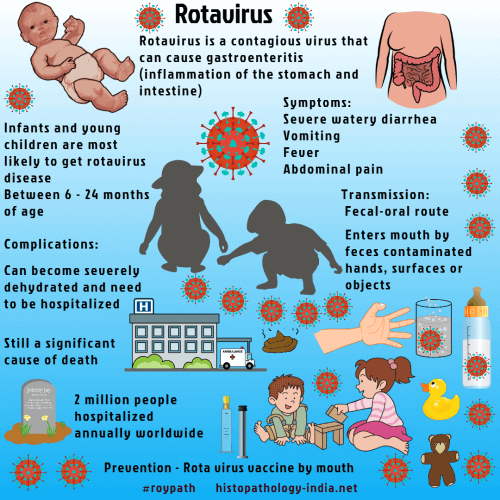
What is Rotavirus
A double-stranded RNA (dsRNA) virus with a segmented genome. It is non-enveloped and has an icosahedral capsid.
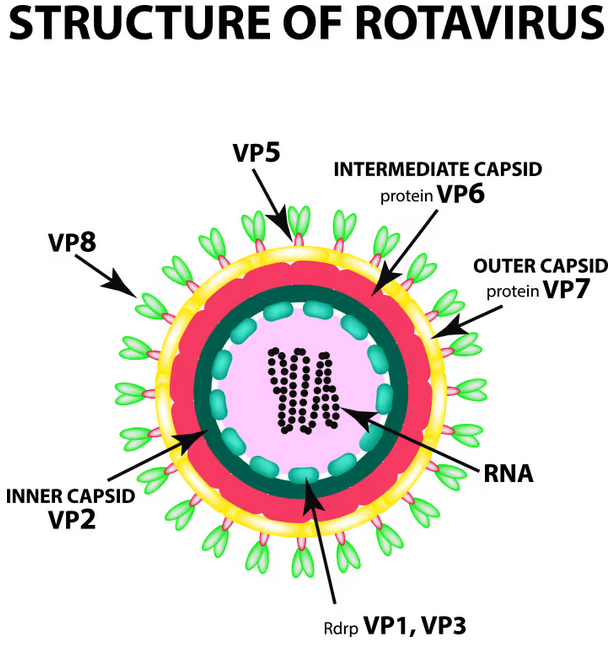
How is Rotavirus transmitted?
Through the fecal-oral route. It is a leading cause of infant gastroenteritis worldwide.
What makes Rotavirus partially resistant to chemicals and heat?
The virus lacks an envelope, making it partially resistant to chemicals and heat.
What is the major viral attachment protein for Rotavirus?
VP4, forming characteristic spikes. It is the target of neutralizing antibodies in vaccinated infants.
Which cells does Rotavirus infect?
Intestinal epithelial cells
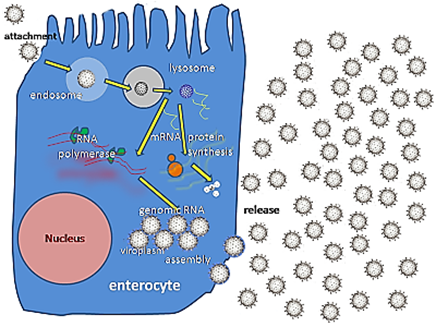
What are the major virulence factors of Rotavirus?
Damage to the intestinal villi and production of enterotoxin NSP4, which increases water excretion and contributes to diarrhea.
What protects against Rotavirus infection in the intestine?
Secretory IgA in the intestine is protective.
What are the three main pathogenic pathways of Rotavirus?
Infection and damage of absorptive intestinal cells
Stimulation of the enteric nervous system
Production of viral enterotoxin NSP4

How is Rotavirus infection treated?
Fluid replacement therapy.
How can Rotavirus be prevented?
Through live-attenuated or hybrid vaccines.
What type of virus is Norovirus?
A positive sense ssRNA virus from the Caliciviridae family. It is non-enveloped and icosahedral.
Is Norovirus resistant to disinfectants and heat?
Yes, Norovirus is resistant to disinfectants, chlorine, heat, and even hand sanitizers.
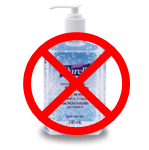
How is Norovirus transmitted?
Mainly via the fecal-oral route (by food handlers), contaminated food and water (like shellfish), and possibly through aerosols during violent vomiting.
What receptor does Norovirus use to infect cells?
It uses the H blood group carbohydrate. People without this carbohydrate have resistance to infection.
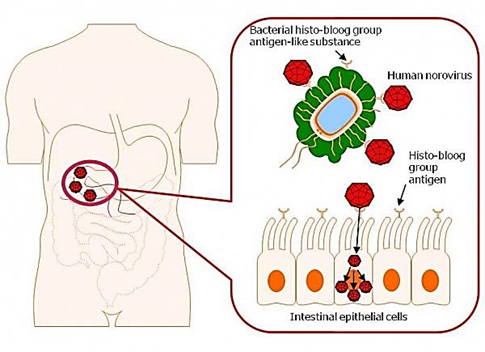
What cells does Norovirus infect?
Intestinal epithelial cells, specifically brush border cells.
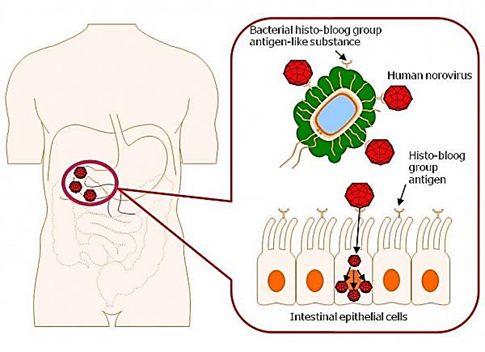
What is the leading cause of epidemic gastroenteritis outbreaks?
Norovirus, especially in cruise ships, schools/dorms, military, and hospitals.

Which populations are more susceptible to Norovirus?
Older children and adults who express the H blood antigen are susceptible.
Infants and young children are less affected because they don’t express the H blood antigen.

What are the main symptoms of Norovirus infection?
Severe diarrhea and vomiting, along with variable symptoms like fever, myalgia, and headaches.

What are Enteroviruses?
A virus that has a positive-sense single-stranded RNA (ssRNA) genome and a non-enveloped, icosahedral capsid.

How are Enteroviruses transmitted?
Mainly through the fecal-oral route (some exceptions exist).
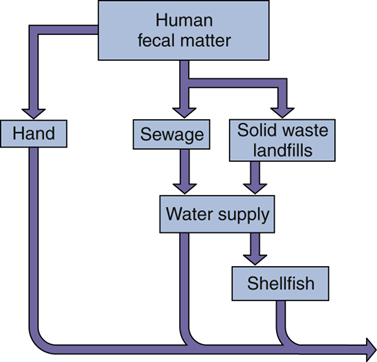
How does Enterovirus infect the body, spread, and how long can it be shed?
It initially replicates in the epithelium of the oropharynx, then spreads to target tissues through viremia (virus in the bloodstream). It can be shed in feces for extended periods.
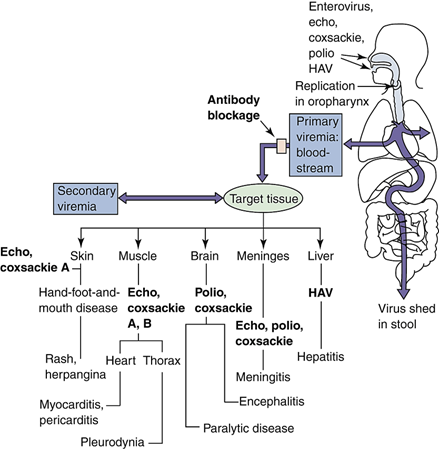
How does the immune system respond to Enteroviral disease?
Antibodies are produced and can limit viremia (virus spreading in the blood), preventing infection of target tissues and major disease.
What causes symptoms in Enteroviral disease?
Symptoms are caused by tissue damage from cytolytic infection (the virus killing infected cells).
What is the viral attachment protein for Poliovirus?
The viral attachment protein is VP4.
What is the receptor for Poliovirus?
The receptor is PVR (poliovirus receptor) or CD155.

How does Poliovirus spread in the body?
Follows this pattern of dissemination:
Oropharynx → GI enterocytes → Peyer’s patch M cells → skeletal muscles → brain via nerves.
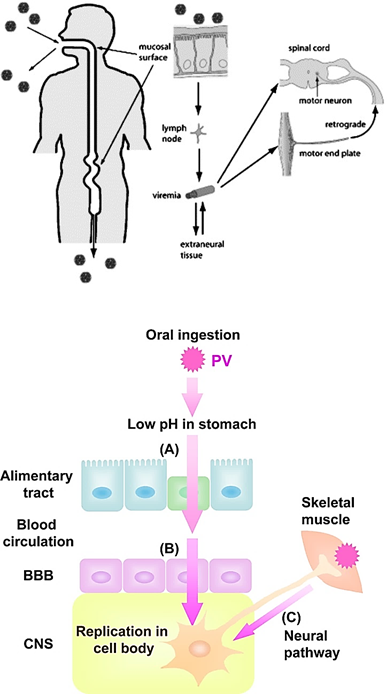
What part of the nervous system does Poliovirus infect?
Motor neurons of the anterior horn and the brainstem.
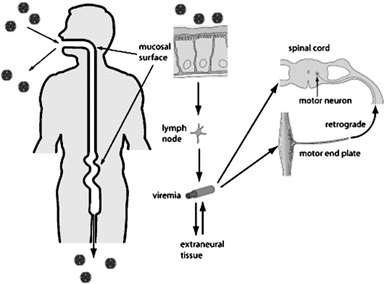
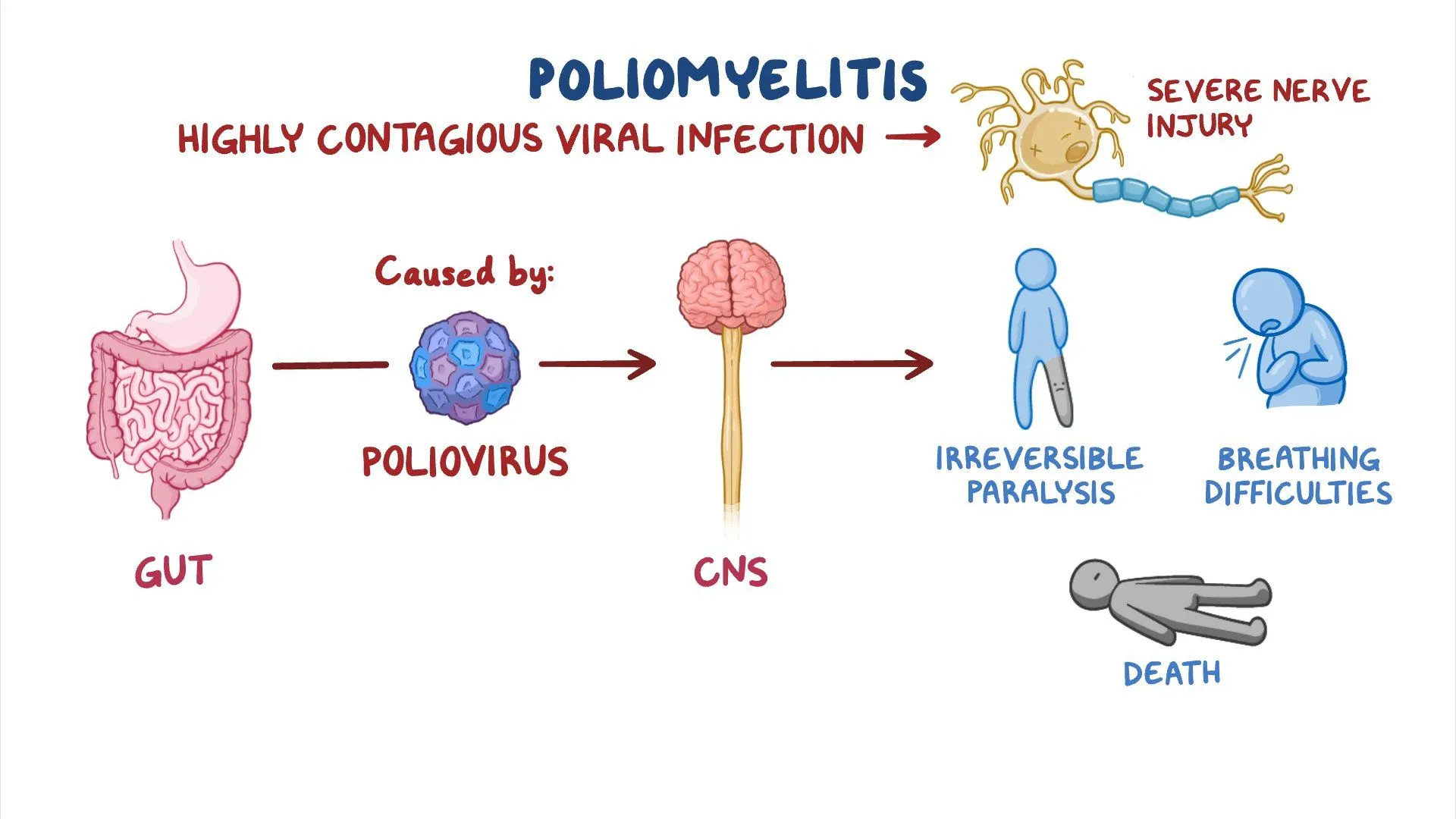
What is a key symptom of Poliovirus disease?
Asymmetric paralysis
What are the phases of primary infection in Poliovirus?
Asymptomatic: virus stays in the oropharynx (90% of infections)
Abortive poliomyelitis or minor illness: fever, virus reaches M cells
Nonparalytic poliomyelitis or aseptic meningitis: virus spreads to CNS, causing back pain and muscle spasms
Paralytic polio or major disease – virus replicates in anterior horn cells of spinal cord and motor cortex, causing varying degrees of paralysis
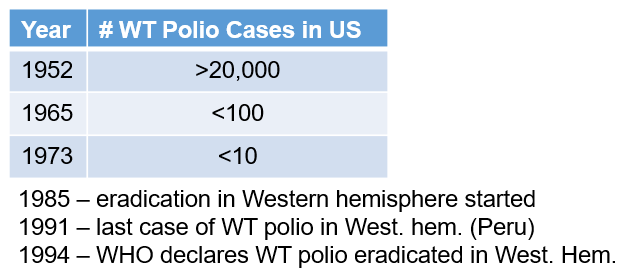
How can poliovirus be prevented?
Polio vaccination/immunization
Inactivated Polio Vaccine
Oral Polio Vaccine
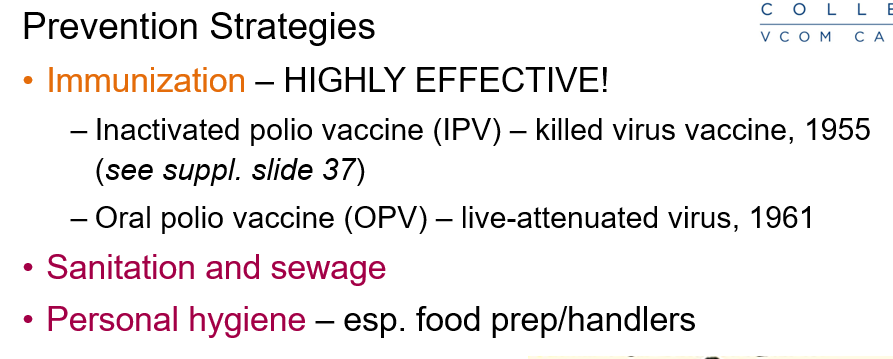
What are the two types of Polio Virus Vaccines and their uses?
IPV (Inactivated Polio Vaccine) – killed virus, used where polio is controlled.
OPV (Oral Polio Vaccine) – live-attenuated virus, used where polio is endemic (risk of reversion).
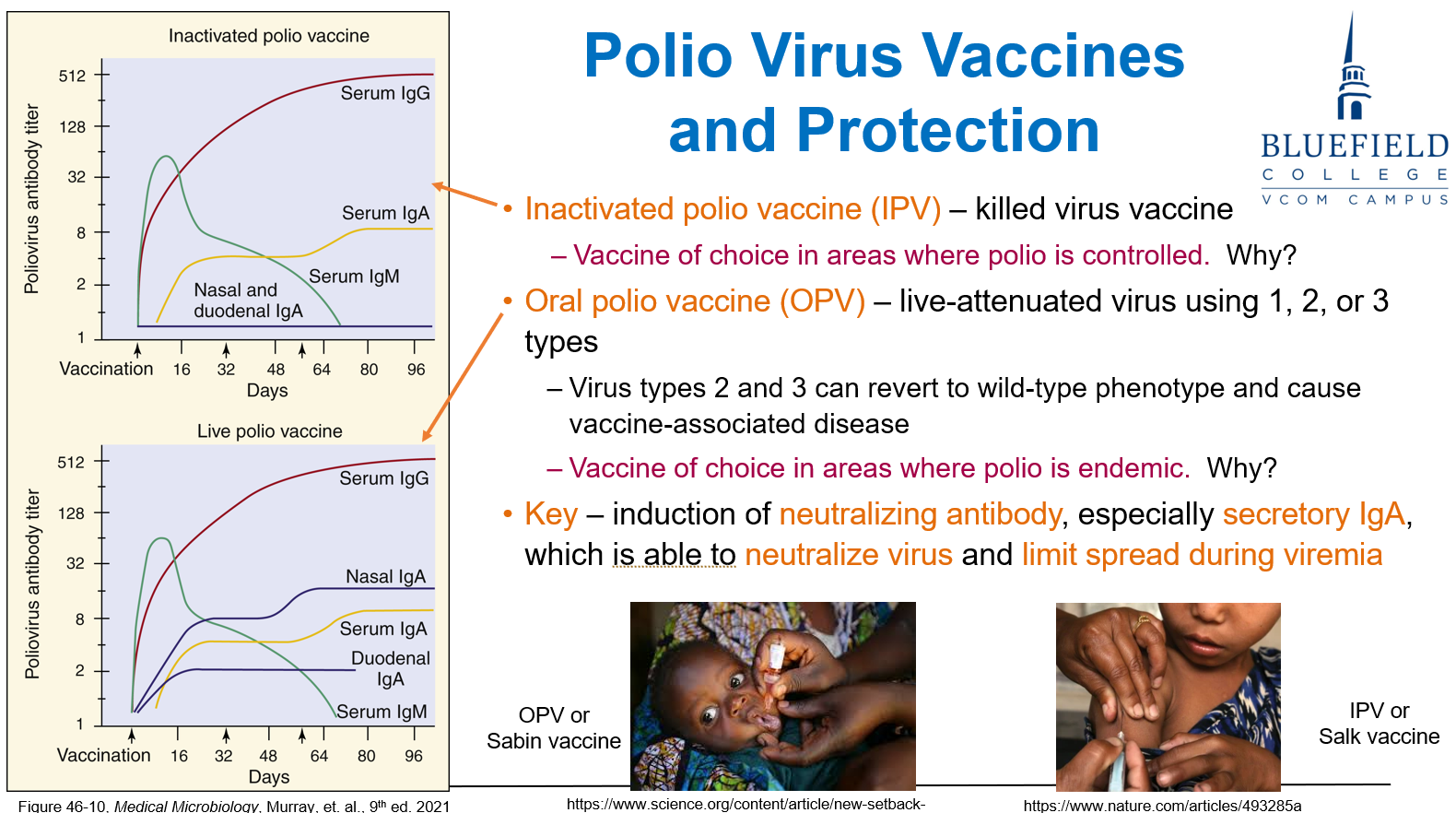
How is Coxsackie virus transmitted
Through respiratory secretions, fecal-oral route, and blister fluid.
What disease does Coxsackie virus cause?
Coxsackie viruses are divided into Group A and Group B. Most are respiratory infections, often Coxsackie A
Respiratory infections (mostly Coxsackie A)
Hand-foot-and-mouth disease
Herpangina (vesicular lesions)
Myocarditis and pericarditis (Coxsackie B)
Mild polio-like disease (Coxsackie A10)
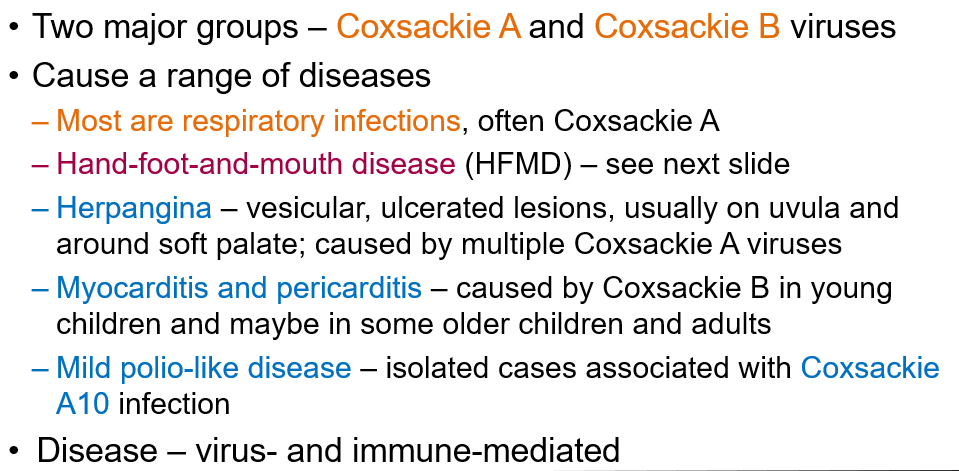
What causes Hand-Foot-and-Mouth Disease (HFMD) and how is it transmitted?
By Coxsackie A viruses. It spreads through feces (diaper changes), fomites, and close contact (like hugs).

What are the symptoms of Hand Foot Mouth Disease?
It causes vesicular lesions on the hands, soles of feet, mouth, and tongue. It is usually self-limiting.
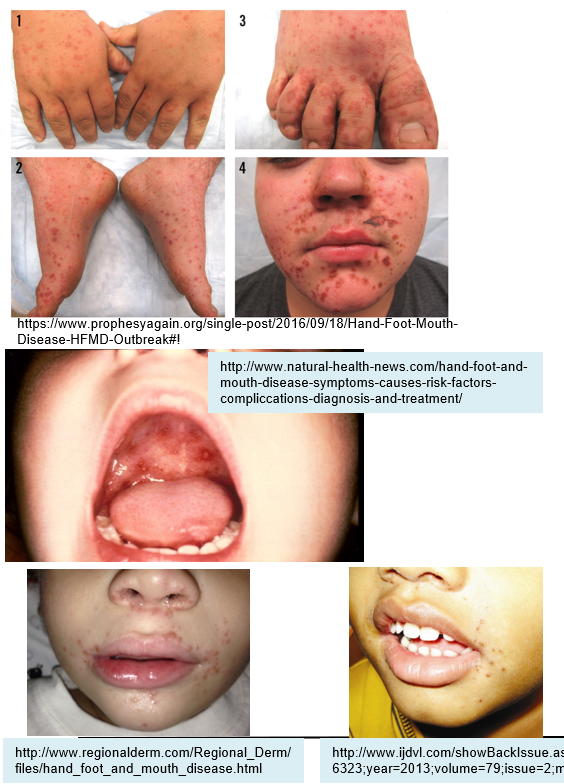
What is Rhinovirus and how is it transmitted?
A Picornaviridae, positive-sense ssRNA virus, non-enveloped with an icosahedral capsid. It transmits via aerosols and fomites.
What are important features of Rhinovirus?
Sensitive to acid pH,
Grows best at <33°C,
Has more than 100 serotypes, uses ICAM-1 as its receptor, and the viral attachment protein is a canyon formed by VP1-4.
How is Rhinovirus transmitted?
Aerosols and fomites.
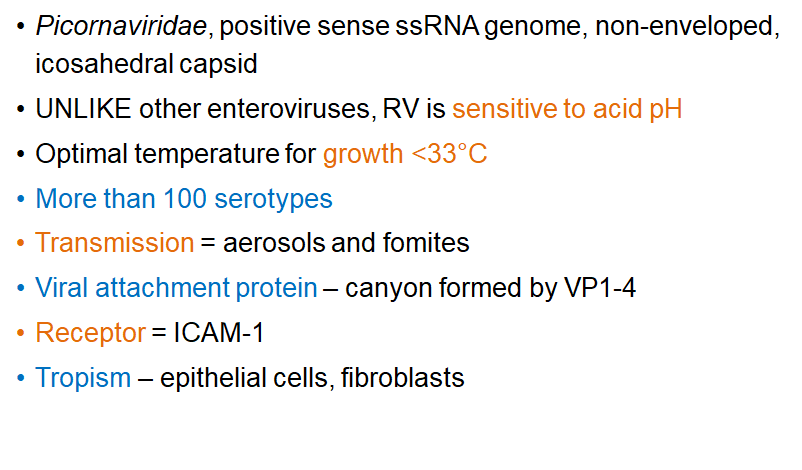
What receptor does Rhinovirus use to enter host cells?
ICAM-1 receptor for cell entry.
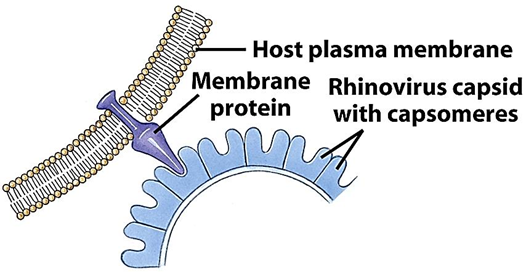
Why does Rhinovirus infection mostly stay in the upper respiratory tract, and what complications can it cause?
It spreads minimally beyond the upper respiratory tract (URT) because of temperature restriction. RV can trigger asthma in susceptible children and cause complications like secondary infections and sinusitis.
How is rhinovirus prevented?
Hygiene, especially handwashing.
What type of genome do Coronaviruses have?
Coronaviruses have a linear positive-sense ssRNA genome, are enveloped, and have a helical capsid.
What is the hallmark structure of Coronaviruses?
They have club-shaped protein peplomers (spike proteins) forming a corona (crown/halo) around the capsid, which helps them protect against acidic GI conditions.

How are Coronaviruses transmitted?
Respiratory droplets and fecal-oral routes.
What cells do Coronaviruses target?
Respiratory or GI epithelium.
What is the viral attachment protein of coronaviruses?
E2 or spike glycoprotein
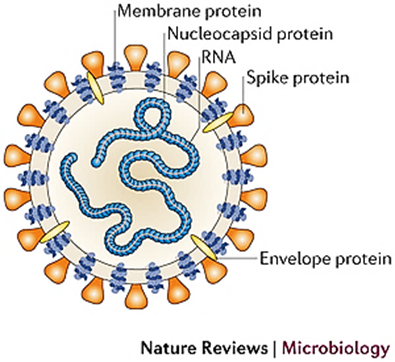
What is the optimal growth temperature for common coronavirus?
Less than 35°C.
What symptoms does common coronavirus usually cause?
mild upper respiratory tract infection similar to rhinovirus.
Does infection with common coronavirus give lasting protection?
No, antibodies made to the E2/spike glycoprotein are short-lived.
Why does common coronavirus generally not cause severe lower respiratory tract infection?
Due to temperature restriction, it generally does not spread to cause severe LRT infection, but there are exceptions.
What causes Severe Acute Respiratory Syndrome (SARS) viruses 1 and 2?
Zoonotic coronaviruses that jumped from animals (civets, raccoon dogs, bats) to humans.
How is SARS transmitted?
Spread by droplets, but the virus is also present in sweat, urine, and stool.
What disease does SARS cause?
It causes atypical pneumonia with symptoms like high fever, chills, headache, malaise, cough, difficulty breathing, and diarrhea.